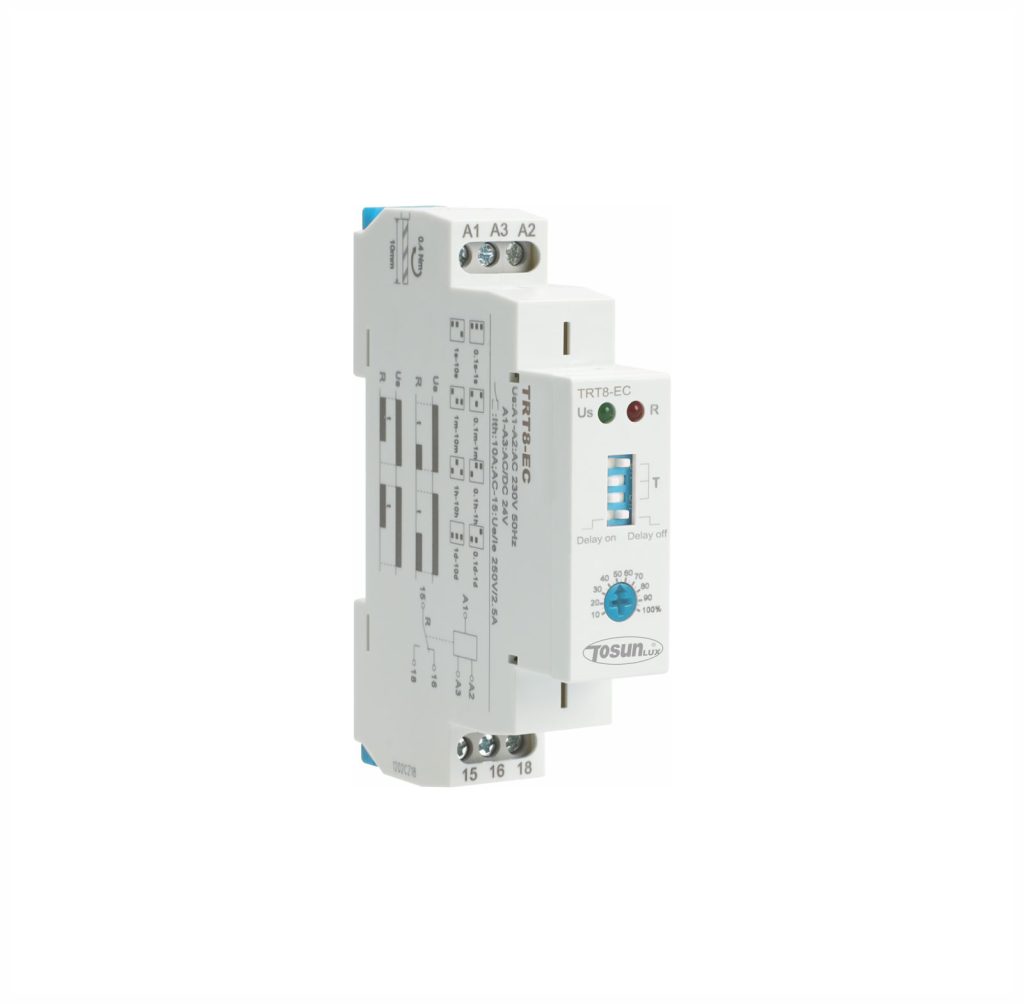Understanding Off-Delay Timer Relay
Table of Contents
ToggleTimer relays are essential devices in electrical systems, offering precise control over when circuits turn on or off.
Among them, the off-delay timer relay plays a key role by keeping a circuit active for a set time after the power is turned off. This functionality makes it ideal for systems that require controlled shutdowns, ensuring safety and efficiency.
Working Principle of an Off-Delay Timer Relay
How does an off-delay timer relay work? The off-delay timer relay works by delaying the disconnection of a circuit.
When you turn off the power, the relay keeps the circuit active for a programmed amount of time before shutting it off completely. This is why it’s called an “off-delay” relay.
Here’s how it works step by step:
- Power On: When the power is switched on, the relay activates instantly, allowing electricity to flow.
- Power Off: When the power is turned off, the relay starts its timer instead of cutting the power immediately.
- Delay Period: During the delay period, the circuit remains active.
- Shut Off: After the delay time runs out, the circuit disconnects.
This mechanism is useful in systems that need extra time to finish a task, like cooling down a motor or completing a process.
Key Components of an Off-Delay Timer Relay
Coil
The coil is the part that creates a magnetic field to activate the relay. When the power is on, the coil energizes and allows the circuit to work.
Timer Module
This component controls the delay period. You can set the timer to delay the circuit shut-off for seconds or even minutes, depending on your needs.
Contacts
Contacts are the switches that open or close the circuit. They stay closed during the delay period and open when the timer runs out.
Adjustment Dial
Many relays have a dial or switches to adjust the delay time. This lets you customize how long the circuit stays active after the power is turned off.
Comparison with On-Delay Timer Relays
While off-delay timer relays and on-delay timer relays sound similar, they work in opposite ways.
Here’s a simple comparison:
| Feature | Off-Delay Timer Relay | On-Delay Timer Relay |
| Function | Delays in turning off the circuit | Delays turning on the circuit |
| When Timer Starts | The timer starts when the power is turned off | The timer starts when the power is turned on |
| Common Use | Motor cooling, lighting delays | Gradual start-up of equipment |
| Example | Keeps a fan running after turning off a heater | Delays the activation of a conveyor belt |
The off-delay timer relay is about keeping things running after shutdown, while the on-delay timer relay focuses on starting things gradually. Both are valuable, but their purposes are entirely different.
Advantages of Off-Delay Timer Relays
Prevents Overheating
Some machines, like motors or ovens, generate heat even after they’re turned off. The off-delay timer relay keeps cooling fans or other safety systems running, preventing overheating.
Improves Safety
In systems with moving parts, like conveyor belts, an off-delay relay ensures everything stops safely. This reduces the risk of accidents caused by sudden shutdowns.
Extends Equipment Lifespan
By allowing machines to cool down or complete a process, the relay reduces wear and tear. This helps extend the life of your equipment.
Saves Energy
Off-delay timers are energy-efficient because they only keep systems running for the necessary time. This ensures power isn’t wasted on unnecessary operations.
Easy Customization
With adjustable timers, off-delay relays can be fine-tuned to suit different needs. Whether you need a delay of a few seconds or several minutes, these relays are flexible.
Applications of Off-Delay Timer Relays
Off-delay timer relays play a critical role in many industries and systems. They are used wherever a controlled shutdown is necessary to ensure safety, efficiency, or reliability.
Here are some detailed examples of their applications:
HVAC Systems
In heating, ventilation, and air conditioning (HVAC) systems, off-delay relays are crucial for managing airflow. When you turn off the system, the relay keeps fans running for a short time to remove excess heat or moisture. This prevents overheating of internal components and ensures proper cooling of the space.
Industrial Machinery
Factories and production lines rely on machinery that must shut down safely. For example, motors driving conveyor belts or robotic arms may need time to complete their cycles after the power is turned off. The off-delay relay ensures that the machinery stops smoothly, avoiding sudden jolts that could damage equipment or cause product defects.
Lighting Systems
Off-delay relays are often used in lighting control systems to keep lights on for a set time after being switched off. This is especially useful in stairwells, hallways, or emergency exits, where lights must remain on long enough for people to pass through safely. In outdoor lighting, these relays can keep lights on for security purposes before gradually turning them off.
Pumps and Water Systems
In irrigation and plumbing systems, maintaining consistent pressure is essential. Off-delay relays keep pumps running briefly after the main system shuts down to avoid pressure drops or water hammer effects. This ensures smoother operation and prevents potential damage to pipes and valves.
Cooling Systems for Motors
Electric motors can generate heat even after they stop running. Off-delay relays allow cooling fans to operate for a while after the motor shuts down, helping dissipate residual heat. This prevents overheating and extends the life of both the motor and the cooling system.
Elevators and Escalators
In public spaces, off-delay relays are used in elevators and escalators to manage power flow during stops. For instance, an escalator may continue to operate for a few seconds to ensure passengers step off safely before it fully shuts down.
Traffic Control Systems
Traffic signals and railway crossings use off-delay relays to maintain safe and efficient operations. For example, a signal light may stay on briefly after a trigger, such as a passing vehicle, to ensure the transition between lights is smooth.
Emergency Systems
Off-delay relays are vital in emergency systems, such as alarm bells or warning lights. These systems need to remain active for a short time after being triggered to ensure everyone has enough time to react to the alert.
Conclusion
An off-delay timer relay is a simple yet powerful tool for managing electrical circuits. It ensures safe, controlled shutdowns by keeping systems active for a set period after the power is turned off.
If you’re looking for high-quality timer relays, TOSUNlux has reliable solutions for all your needs. Get a quote today and find the perfect off-delay timer relay for your system.
Tel: +86-577-88671000
E-mail: ceo@tosun.com
Skype: tosunelectric
Wechat: +86-139 6881 9286
WhatsApp: +86-139 0587 7291
Address: Room No.1001 Wenzhou Fortune Center,Station Road, Wenzhou, China
REQUEST A QUOTE
WhatsApp us
 : +86-139 0587 7291
: +86-139 0587 7291 English
English Español
Español Русский
Русский Français
Français العربية
العربية Português do Brasil
Português do Brasil Українська
Українська Türkçe
Türkçe Polski
Polski Nederlands
Nederlands Italiano
Italiano Bahasa Indonesia
Bahasa Indonesia हिन्दी
हिन्दी اردو
اردو አማርኛ
አማርኛ Հայերեն
Հայերեն ไทย
ไทย Монгол
Монгол فارسی
فارسی Shqip
Shqip Ελληνικά
Ελληνικά



